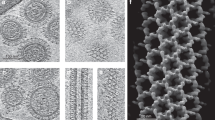Summary
A non-ionic detergent method of cell fractionation was used to follow the time course of tritiated uridine incorporation into influenza A-NWS virus-induced RNA in a continuous mammalian cell line. The maximum incorporation of tritiated uridine into acid-insoluble RNA of nuclear fractions occurred at 2 to 2.5 hours post infection. A maximum of labelled acid-insoluble RNA of the cytoplasmic fractions was found at 3 to 4 hours post infection which coincided with active synthesis of infectious virus. The effect of influenza A-NWS infection on the rate of tritiated thymidine incorporation into acid-insoluble DNA was found to be an initial depression 1 to 2 hours post infection followed by recovery to near normal values, then a gradual decline until at 8 hours post infection it was approximately 60% of that shown by the control cell cultures.
Similar content being viewed by others
References
Bell, W. C., andH. F. Maassab: Action of hydroxyurea on multiplication of influenza virus in mammalian cells, Nature (Lond.)217, 646–647 (1968).
Borland, R., andB. W. J. Mahy: Deoxyribonucleic acid-dependent ribonucleic acid polymerase activity in cells infected with influenza virus, J. Virol.2, 33–39 (1968).
Breitenfeld, P. M., andW. Schäfer: The formation of fowl plaque virus antigens in infected cells, as studied with fluorescent antibodies, Virology4, 328–345 (1957).
Burton, K.: A study of the conditions and mechanisms of the diphenylamine reaction for the colorimetric estimation of deoxyribonucleic acid, Biochem. J.62, 315–323 (1956).
Butler, F. E.: Determination of tritium in water and urine, Ann. Chem.33, 409 (1961).
Dische, Z.: “Color Reactions of Nucleic Acid Components”, in: The Nucleic Acids (E. Chargaff andJ. N. Davidson, eds.), New York: Academic Press1, 285–305 (1955).
Duesberg, P. H., andW. S. Robinson: On the structure and replication of influenza virus, J. molec. Biol.25, 383–405 (1967).
Fazekas de St. Groth, S., andD. M. Graham: The production of incomplete virus particles among influenza strains: Experiments in eggs, Brit. J. exp. Path.35, 60–74 (1954).
Fazekas de St. Groth, S., andD. M. Graham: The production of incomplete virus particles among influenza strains: Chemical induction of the von Magnus phenomenon, Brit. J. exp. Path.36, 205–213 (1955).
Fisher, H. W., andH. Harris: The isolation of nucleic acid from animal cells in culture, Proc. roy. Soc. B.156, 521–523 (1962).
Fisher, H. W., andH. Harris: Isolation of nucleic acid from animal cell suspensions, Nature (Lond.)196, 910 (1962).
Fisher, H. W., H. Matsumiya, andM. Azuma: Application of cell fractionation techniques in the study of cells infected with polyoma virus and Newcastle disease virus, J. Bact.91, 1645–1651 (1966).
Granoff, A., andD. W. Kingsbury: Effect of Actinomycin D on the replication of Newcastle disease and influenza viruses, in “Cellular Biology of Myxovirus Infections”, CIBA Found. Symp. pp. 96–115. Boston: Little Brown & Co., 1964.
Hanks, J. H., andR. E. Wallace: Relation of oxygen and temperature in preservation of tissues by refrigeration, Proc. Soc. exp. Biol. (N.Y.)71, 196–200 (1949).
Holmes, K. V., andP. W. Choppin: On the role of the response of the cell membrane in determining virus virulence. Contrasting effects of the parainfluenza virus SV5 in two cell types. J. exp. Med.124, 501–520 (1966).
Munro, H. N., andA. Fleck: The determination of nucleic acids, in “Methods of Biochemical Analysis”, D. Glick (ed.), pp. 113–176. New York: Interscience Publishers, 1966.
Nayak, D. P., andA. F. Rasmussen: Influence of mitomycin C on the replication of influenza viruses, Virology30, 673–683 (1966).
Nayak, D. P., andM. A. Baluda: Isolation and characterization of nucleic acid of influenza virus. J. Virol.1, 1217–1223 (1967).
Nayak, D. P., andM. A. Baluda: Ribonucleie acid synthesis in cells infected with influenza virus. J. Virol.2, 99–109 (1968a).
Nayak, D. P., andM. A. Baluda: An intermediate in the replication of influenza virus ENA, Proc. nat. Acad. Sci. (Wash.)59, 184–191 (1968b).
Pons, M. W.: Studies on influenza virus ribonucleic acid, Virology31, 523–531 (1967a).
Pons, M. W.: Effect of actinomycin D on the replication of influenza virus and influenza virus RNA, Virology33, 150–154 (1967b).
Rott, R., S. Saber, andC. Scholtissek: Effect on myxovirus of mitomycin C, actinomycin D, and pretreatment of the host cell with ultraviolet light, Nature (Lond.)205, 1187–1190 (1965).
Schmidt, G., andS. J. Thannhauser: Method for determination of desoxyribonucleic acid, ribonucleie acid, and phosphoproteins in animal tissues, J. biol. Chem.161, 83–89 (1945).
Scholtissek, C., undR. Rott: Zusammenhänge zwischen der Synthese von Ribonucleinsäure und Protein bei der Vermehrung eines Virus der Influenza-Gruppe (Virus der klassischen Geflügelpest), Z. Naturforsch.16b, 663–673 (1961a).
Scholtissek, C., undR. Rott: Untersuchungen über die Vermehrung des Virus der klassischen Geflügelpest. Die Synthese der virusspezifischen Ribonucleinsäure (RNA) in infizierten Gewebekulturen embryonaler Hühnerzellen. Z. Naturforsch.16b, 109–115 (1961b).
Scholtissek, C., R. Rott, P. Hausen, H. Hausen, andW. Schäfer: Comparative studies of RNA and protein synthesis with a myxovirus and a small polyhedral virus, Cold Spr. Harb. Symp. quant. Biol.27, 245–257 (1962).
Stuart-Harris, C. H.: A neurotropic strain of human influenza virus, Lancet1, 497–499 (1939).
Sugiura, A., andE. D. Kilbourne: Genetic studies on influenza viruses. II. Plaque formation by influenza viruses in a clone of a variant human heteroploid cell line, Virology26, 478–488 (1965).
Wong, S. C., andE. D. Kilbourne: Changing viral susceptibility of a human cell line in continuous cultivation. I. Production of infective virus in a variant of the Chang conjunctival cell following infection with swine or N-WS influenza virus. J. exp. Med.113, 95–110 (1961).
Author information
Authors and Affiliations
Additional information
This paper is part of a dissertation submitted byWilliam C. Bell in partial fulfillment of the requirements for the degree of Doctor of Philosophy from the University of Michigan. Supported in part by Graduate Training Grants from Nat. Inst. of Allergy and Infect. Dis., NIH 5 T1 AI-60.
This investigation was conducted in part under the sponsorship of the Commission on Influenza, Armed Forces Epidemiological Board, and was supported by the U.S. Army Medical Research and Development Command, Department of the Army, under research contract DA-49-193-MD-2066.
Rights and permissions
About this article
Cite this article
Bell, W.C., Maassab, H.F. Nucleo-cytoplasmic studies in the development of influenza virus in mammalian cells. Archiv f Virusforschung 27, 128–137 (1969). https://doi.org/10.1007/BF01249638
Received:
Issue Date:
DOI: https://doi.org/10.1007/BF01249638




